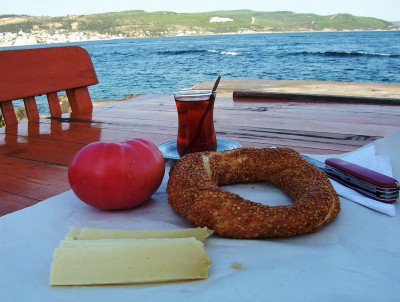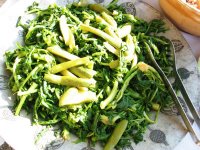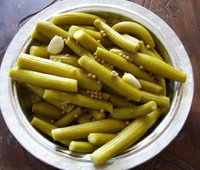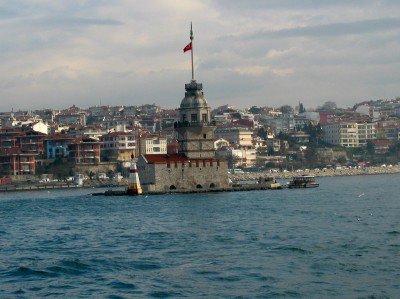
I once wrote an article called 'Onion to your left and garlic to your right'which
was published in a book. In Turkey, some people cannot differ left and right easily. Left is 'sol' and right is 'sag' in Turkish. Onion is 'sogan' and garlic is 'sarimsak' so we say, 'soluna sogan, sagina sarimsak' to remember it easily. (I hope this doesn't sound unnecessary information to you but I find it funny and that's why I used it as the heading of the article.)

In that article, I listed some of the superstition related to garlic. For example in the very old times, it's used to keep the devils and bad spirits away from the houses. It's still used in some Anatolian villages. In another belief, genies (or bad spirits) give lots of golden money and jewellery to the people whom they
want to cheat and when the power of sorcery is over, it's believed that the money and the jewellery would turn into onions and garlic. In one other belief, it's believed that if you rub garlic or onion under your shoes on new years eve, neither snakes nor scorpions may harm you.
I wrote this paragraph to a group this morning. Then I decided to continue from here for the new update. At the beginning, I thought I could write more often but as time goes by, I realized that it takes more time and effort than writing in my own language. So each time I sat on my chair to write something in English, I found myself doing other things rather than writing for my English blog. I actually even found topics to write about. One was ‘simit’ (the round, crispy bread with lots of sesame seeds) which is one of the ‘staple’ foods (really!) for Turks. Simit-kasar-çay is like Daltons for us. You cannot seperate one from the other. Simit, I told about. You can see ‘simitçi’ (simit seller) on Istanbul streets. It can be eaten at any hour. For breakfast, for lunch, for afternoon tea, even for dinner! Kasar is our wonderful cheese which is somehow like gruyer or cheddar cheese but it’s different. Let me give you the explanation from Suzanne Swan’s wonderful book, The Treasury of Turkish Cheeses (Boyut Publishing, Istanbul, Turkey, 2004): “This is Turkey’s best-known and most popular cheese. It resembles a mild or medium Cheddar and they both have the same pale yellow colour and texture and gain their unique flavour after being left on shelves to mature over several months. Eski (Old) Kasar, produced in wheel-shaped moulds, mostly around Van and Kars. The cheese seller cuts off as much as you require.” Çay is of course, our beloved tea which can be drunk at an hour of the day, with or after the meals but especially for breakfast. In summer, tomatoes are wonderful additions for this trio.

Yes, this was one of the subjects but I actually wanted to talk about the wonderful wild greens of Turkey. There is so much to tell about them. For my book A Tale of Wild Greens I researched on over 50 of them but if you go deeper and on regional scale, you can find easily over 200 edible greens.

Sometimes shoots are eaten, sometimes roots or leaves. You can either boil them and eat as a salad or fry or saute with onions and some other ingredients. Cooking the greens with bulghur (or rice) is another way of using them. You’ll see an example for this dish at the end of this post. Böreks are also special for Turks. So wild greens are used in many regions and in many different börek (phyllo dough dishes) recipes. You can add them in breads, cook with grains or legumes... There are so many ways of cooking them.

What are the most popular greens of Turkey? As I said there are so many of them but here I’ll name few of them: hodan (borage, borago officinalis), kusotu (chickweed, stellaria media), arapsaçi (wild fennel, foeniculum vulgare), yemlik (goat’s beard, tragopogon spp), kenger (milk thistle, onopordum or scolymus spp), madimak (polygonum cognatum), ebegümeci (mallow, malva silvestris), turpotu (white mustard, sinapis alba), tilkisen (wild asparagus, asparagus acutifolius), isirgan (nettle, urtica dioica), gelincik (poppy, papaver rhoeas), kuskus otu (shepherd’s purse, capsella bursa-pastoris), kuzukulagi (sorrel, rumex acetosa), hindiba (taraxacum officinale), köremen (wild garlic, allium spp)... These are only the few of a wide variety of greens. We also use oregano, thyme, sage, marjoram, laurel leaves both in cooking and to make herbal teas. They’re and so many other wild herbs and aromatic plants are used for healing too.

Since I cannot mention all of the uses and names, I wanted to keep it simple and give you an idea of what can be done with them. In A Tale of Wild Greens, I gave 153 recipes for how to use them creatively. As I said above, you can cook them in so many ways. Soups, starters, omelettes, main meals, breads, pastries, beverages and some alcoholic drinks, even sweets, pickles... What you need to do is to use your creativity. You can ask me for local uses of them if you wish. Here is the bulghur recipe with wild greens. You can use nettle, chickweed, wild fennel, goat’s beard, mallow, plantain as well as spinach, kale or chard or a combination of greens for this recipe:
Bulghur rice with wild greens (4-6 servings)
A big bunch of (approx a pound or half kilo) wild greens
2-3 leeks, cut in thin rounds
2 onions, cut in small pieces
1 ½ cups of bulghur*
3 cups of boiled water
3-4 tablespoons of olive oil or a tablespoon of butter
salt, pepper and red pepper
Heat oil in a pot, add onions and leeks. Saute them for 10 minutes on medium heat stirring once in a while. Add cleaned, washed and cut greens and cook for few more minutes. Then add washed and rinsed bulghur, hot water, salt, pepper and red pepper and cover the pot. Lower heat to very low and cook until all the water is evaporated. You can serve this meal with yoghurt or ayran** or with meats.
* You can find bulghur on health food stores or stores where Turkish or Middle Eastern ingredients are sold.
** Ayran is a summer drink which we love. It’s made with yoghurt, water and a bit of salt. All you need to do is to beat the ingredients until it becomes foamy. It’s preferred cold.











